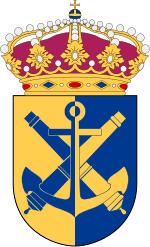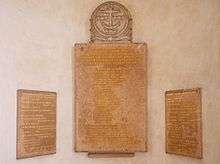East Coast Naval Base
| East Coast Naval Base | |
|---|---|
| Ostkustens marinbas | |
 | |
| Active | 1928–2004 |
| Country | Sweden |
| Allegiance | Swedish Armed Forces |
| Branch | Swedish Navy |
| Type | Naval base |
| Part of |
Milo Ö (1942–1991) Milo M (1991–2000) MTS (2000–2004) |
| Garrison/HQ |
Stockholm (1928–1966) Stockholm/Haninge (Muskö)[1] (1966–2004) |
| Colors | Yellow and blue |
| March | "Amiral Wilhelm Dyrssen" (Emil Dahlström) |
East Coast Naval Base[2] (Swedish: Ostkustens marinbas, MarinB O) was a Swedish Navy command body which operated in various forms between the years 1928 and 2004. It was located in Stockholm from 1928 to 1966 and then in Haninge Municipality from 1966 to 2004.
History
In accordance with the Defence Act of 1925, from 1928, six regional command and maintenance bodies for the Swedish Navy were organized within the respective coastal areas.[3] During the 1930s, the regional naval structure was built in the form of naval districts (initially only in the war organization, but later in war as well as in peace).[4] The East Coast Naval District (Ostkustens marindistrikt, MDO), based in Stockholm, stretched from Öregrundsgrepen, near Gräsö (Björn's Lighthouse) to the northern part of Kalmar Strait (Kråkelund).[5] The naval districts replaced the naval stations[6] and were upgraded in 1957 to naval commands (marinkommandon) and was given operational responsibility (higher regional level).[4] From 1966 to 1990 they were called naval bases (örlogsbaser) and patrol areas (bevakningsområden).[6] In 1966, new and from then on integrated military areas were established, which took over some of the tasks of the naval commands. Other tasks were transferred simultaneously to the newly established naval bases (lower regional level). During the period 1981-1990, the naval bases were amalgamated with respective coastal artillery defence and formed naval commands - now at a lower regional level.[4] For East Coast Naval Base (Ostkustens örlogsbas, ÖrlB O), this meant that its was amalgamated with Stockholm Coastal Artillery Defense (Stockholms kustartilleriförsvar, SK) and formed the East Coast Naval Command (Ostkustens marinkommando, MKO).[7]
The lower regional organization had command duties and was responsible for, among other things, maritime surveillance and maritime maintenance, base services.[6] The majority of the regional structure was discontinued in 2000 and replaced with two naval bases and a naval shipyard. At the same time the Naval Tactical Command was established.[6] The organization was formed on 1 July 2000 and took over certain parts of the operation after the East Coast Naval Command (Ostkustens marinkommando, MKO).[8] The Naval Base (Marinbasen, MarinB) was formed on 1 January 2005 after the Defence Act of 2004. The Naval Base took over the main tasks previously relinquished to the East Coast Naval Base (Ostkustens marinbas, MarinB O) and the South Coast Naval Base (Sydkustens marinbas, MarinB S). Today, it is the Naval Base, which has in principle taken over the remaining naval tasks of the lower regional structure.[4]
Heraldry and traditions
Its colour was a double swallow-tailed Swedish flag. The flag was presented in 1976.[9] Ostkustens marinbas minnesmedalj (MarinBOMSM) ("East Coast Naval Base Commemorative Medal) in silver was established in 2005.[10] The traditions of the East Coast Naval Base and its predecessors are kept by Marinbasen.[11]
Commanding officers

Commanding officers:[12]
- 1933–1936 – Charles de Champs
- 1936–1942 – Claës Lindsström
- 1942–1945 – Hans Simonsson
- 1945–1951 – Yngve Ekstrand
- 1951–1957 – Erik Anderberg
- 1957–1966 – Erik af Klint
- 1966–1971 – Einar Blidberg
- 1971–1977 – Lars H:son Lundberg
- 1977–1983 – Christer Kierkegaard
- 1983–1986 – Bengt O'Konor
- 1986–1988 – Hans Tynnerström
- 1988–1993 – Gunnar-Bo Ericson
- 1993–1996 – Gunnar Bengtsson
- 1996–2000 – Ulf Edman
- 2000–2001 – Björn Nordbeck
- 2001–2003 – Rolf Brehmer
- 2003–2004 – Claes-Göran Hagström
Name and designation
| Designation | Name | Translation | Active | Notes |
|---|---|---|---|---|
| MDO | Ostkustens marindistrikt | East Coast Naval District[2] | 1928–1957 | Reorganized in 1957 into Naval Command East (Marinkommando Ost). |
| MKO | Marinkommando Ost | Naval Command East[2] | 1957–1966 | Reorganized in 1966 into East Coast Naval Base (Ostkustens örlogsbas). |
| ÖrlB O | Ostkustens örlogsbas | East Coast Naval Base[2] | 1966–1990 | |
| MKO | Ostkustens marinkommando | East Coast Naval Command | 1990–2000 | |
| MarinB O | Ostkustens marinbas | East Coast Naval Base | 2000-07-01 – 2004 |
References
- ↑ Förordning om ändring i förordningen (1994:642) med instruktion för Försvarsmakten (PDF) (in Swedish). Stockholm: Svensk författningssamling. 16 June 1999. p. 5. LIBRIS 8261432.
- 1 2 3 4 Appich, Jr., Thomas W. (22 July 1988). "REFERENCE AID SWEDISH-ENGLISH GLOSSARY OF MILITARY AND TECHNICAL ACRONYMS AND ABBREVIATIONS" (PDF). Joint Publications Research Service. Foreign Broadcast Information Service. pp. 105, 110, 187. Archived from the original (PDF) on 20 February 2017. Retrieved 9 September 2018.
- ↑ Degerström, Anders; Ericson, Lars; Söderberg, Ulf (June 2005). "FÖRSVARETS REGIONALA OCH LOKALA ORGANISATION" [SWEDISH DEFENSE REGIONAL AND LOCAL ORGANIZATION] (in Swedish). National Archives of Sweden. Retrieved 17 May 2018.
- 1 2 3 4 Försvarets traditioner i framtiden med översiktlig historik från 1500-talet (PDF) (in Swedish). Statens försvarshistoriska museer TradN. 2015. p. 13. ISBN 9789197859554. LIBRIS 17552963. Archived from the original on 2016-08-17.
- ↑ Stille, Åke (1954). "Om de primära örlogsbaserna vid Östersjön och Nordsjön ur strategisk-geografisk synpunk" (PDF). Forum navale: skrifter (in Swedish). Uppsala: Sjöhistoriska samfundet (12): 24. LIBRIS 3615255.
- 1 2 3 4 Försvarets traditioner i framtiden med översiktlig historik från 1500-talet (PDF) (in Swedish). Statens försvarshistoriska museer TradN. 2015. p. 27. ISBN 9789197859554. LIBRIS 17552963. Archived from the original on 2016-08-17.
- ↑ O'Konor, Bengt (1998). "Marin organisation inför sekelskiftet". Vårt försvar: tidskrift (in Swedish). Stockholm: Allmänna försvarsföreningen. 109 (3). LIBRIS 3430365. Retrieved 17 May 2018.
- ↑ "Rapport efter arkivinspektion vid Ostkustens marinbas (MarinB O) på Muskö den 22 april 2004" (in Swedish). National Archives of Sweden. 2004. Retrieved 16 May 2018.
- ↑ Braunstein, Christian (2004). Svenska försvarsmaktens fälttecken efter millennieskiftet [The flags and standards of the Swedish armed forces after the turn of the millennium] (PDF). Skrift / Statens försvarshistoriska museer, 1101-7023 ; 7 [dvs 8] (in Swedish). Stockholm: Statens försvarshistoriska museer. p. 68. ISBN 91-971584-7-X. LIBRIS 9815350.
- ↑ "MarinBOMSM: Ostkustens marinbas (MarinB O) minnesmedalj". www.medalj.nu (in Swedish). 2007-08-22. Retrieved 16 May 2018.
- ↑ Försvarets traditioner i framtiden med översiktlig historik från 1500-talet (PDF) (in Swedish). Statens försvarshistoriska museer TradN. 2015. p. 30. ISBN 9789197859554. LIBRIS 17552963. Archived from the original on 2016-08-17.
- ↑ Birke, Sune; Braunstein, Christian (2011). Sveriges marina förband och skolor under 1900-talet. Skrift / Statens försvarshistoriska museer, 1101-7023 ; 13 (in Swedish). Stockholm: Statens försvarshistoriska museer. p. 41. LIBRIS 12638815.